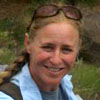Child's Play
The Taos Collaborative Archaeology Project, led by Prof. Sunday Eiselt, is looking for toys from the past.

By Julian Smith
The full moon casts a warm glow across the dirt plaza of Ranchos de Taos and the adobe walls of the church of Saint Francis of Assisi, made famous by the paintings of Georgia O’Keeffe.
Inside the parish hall, archaeologist Sunday Eiselt of Southern Methodist University (SMU) faces a small crowd. She’s a little nervous. Eiselt is about to ask the residents of this conservative Hispanic community near Taos, New Mexico, for permission to dig up their backyards and the floors of their centuries-old homes. Today, the area is known as a ski town and a magnet for both the super-rich and hippie artists, but the community was founded in the 17th century, and is one of the oldest in the country.
“We’re not here to dig and leave,” Eiselt says once the audience is settled. “We want you to tell us where to look and what to look for.”
She emphasizes that the Taos Collaborative Archaeology Project can only move forward with the community’s blessing and support. Started by Eiselt in 2007, the project is part of a broad-based effort to investigate the history of Taos.
Locals begin to ask questions about the excavations and eventually offer suggestions on where to look. Father Francis Malley, the parish priest, promises to announce the project in next week’s mass and put it in the church bulletin. Everyone is enthusiastic, which probably has something to do with the project’s surprising goal: instead of ancient ceramics or prehistoric fire pits, Eiselt and her SMU students are looking for toys.
Read the full online version. (A more complete story appears in the printed version.)
# # #